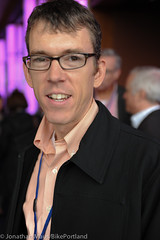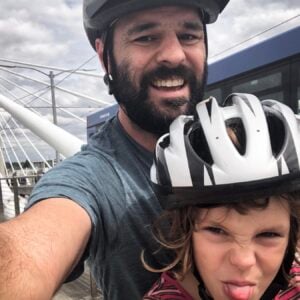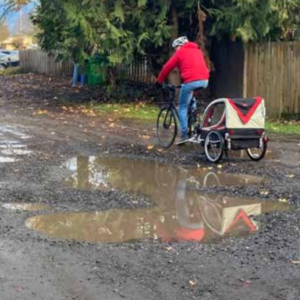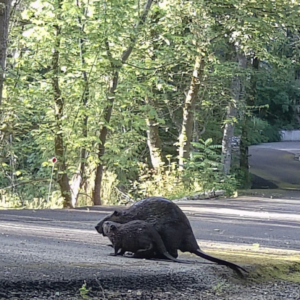“I respectfully disagree with you on the topic of traffic signals and support the dialogue on speed limits.”
— A good opening line to a blog comment.
I say it a lot in private conversations, but perhaps not enough here on the Front Page: I believe the most valuable part of BikePortland isn’t the words and pictures we share, but the comments that appear below them. Since the early days, the comments are what have given this site its mojo and they’re what has given me the excitement and energy to keep on blogging.
I could write a book about all my blog comment thoughts and practices, and all the crazy/amazing things that have happened in our comments section. But today, I just want to share one that was written a few days ago by a City of Portland staffer. And not just any staffer, one of a select few Division Managers who actually run things and make important decisions about transportation policy and projects in our city. Peter Koonce is the Manager of PBOT’s Signals, Street Lighting, & ITS (Intelligent Transportation Systems) Division. He is not only a national leader in how to make signals work better, he also “gets it” when it comes to engaging with the public he serves (and his personal, yet work-related blog isn’t too shabby either).
On our story last week about Mayor Hales’ safety efforts, a discussion in the comments started about signals. A reader was critical of PBOT’s signal policy, saying that it favors who people who drive. Koonce, a regular BikePortland reader, replied with his perspective on the issue. Koonce used his full name (a practice I strongly recommend), said he disagreed with the reader’s view, and then made a comprehensive and respectful argument as to why.
Here’s the comment:
Dan-
I respectfully disagree with you on the topic of traffic signals and support the dialogue on speed limits. There are 1,070 traffic signals in Portland and not all are designed for cars to “move faster”. A good number of them (250) are in downtown and are used to manage traffic carefully to insure speeds are safe for all users (especially pedestrians crossing right turning traffic and people on bikes sharing the lane or in a bike lane). Our policies in downtown prioritize multimodal movement and safety and have for thirty years. We have been extending that concept to recent projects like the Burnside-Couch couplet which are set up to progress all traffic at 20 miles per hour. Granted, cars can move faster then that, but our intent is to manage the traffic so the traffic signals are a positive influence on the safety of the street. This is not a one sized fits all proposition. The adjacent buildings and activity of pedestrian and bicycle travel play a significant role. What works in downtown doesn’t on 82nd Avenue.
Traffic signals aren’t a panacea for safety either. In situations with two way traffic, we can’t manage the speeds like we do in a grid of streets with nearby signals. There are a number of corridors where the signals are so distant that they do move cars faster than if they weren’t there, but any intersection treatment would have the propensity to do that.
I can’t stress enough that context is important, but there is also difficulty in changing the status quo with only a change to the traffic signals. There has to be the right context and other supportive efforts to make change happen. Just as the concepts of Missouri aren’t likely to show up in Portland any time soon, the ideas of one intersection in England would have to be used with the right context and community support.
Your later comment on lower speed limits and the resulting dialogue should be considered further in a Vision Zero type effort. Reducing speed limits, combined with effective enforcement, including working with the judicial system, would only be effective with a comprehensive focus on the problem. That’s what leadership looks like.
If there are traffic signals that you think encourage speeding, ask City staff to take a look at them. If there are streets that seem to have speed limits that are set unreasonably high, call the 503-823-SAFE hotline. The City uses good feedback to make change happen, sometimes incrementally but it all adds up.
I don’t want to get into who’s right or wrong on the specific issue, but I hope other city staffers (both in Portland and beyond), take time to read Koonce’s comment and keep in mind that you shouldn’t be afraid of blogs. Too often city staff are dismissive of blog comments as some sort of cesspool of ignorance and anger; but here on BikePortland, that couldn’t be further from the truth (sure, sometimes things get messy, but that’s just the nature of a public forum).
I am grateful for the level of quality and care people take with their comments here and I am especially thankful that influential city staff like Peter Koonce take their valuable time to defend their work, engage with us, and add to the conversation.






Thanks for reading.
BikePortland has served this community with independent community journalism since 2005. We rely on subscriptions from readers like you to survive. Your financial support is vital in keeping this valuable resource alive and well.
Please subscribe today to strengthen and expand our work.
Koonce is right on the money. The problems generally occur on the bi-directional streets, or streets with large gaps between the signals. Most drivers accelerate, exceed the speed limit, and then come to a stop a few seconds before the next light goes green. The best thing we can do is to try and time the lights while driving, requiring everyone behind us to go the same speed. You might get a few honks, but you save gas, and you make the city safer for everyone.
I cannot overstate my love of Peter Koonce and the my interactions with him. Here’s the latest example:
Riding with a friend from Seattle (Madi Carlson, who was here to ride in the DRT) I warned her that even though we could see it was still a green light at the upcoming intersection, I would be stopping. It had been green for awhile & I know that I can’t make it through that intersection if I’m not first in line when the light changes to green. (This was southbound on SE 28th at SE Stark.) She said something like, “Isn’t there that guy you can tweet at that wanted to know what other intersections you had problems with?” Duh. I tweeted at Mr. Koonce the next day, a Friday, and saw that he favorited my tweet along with replying to me. The next Thursday he tweeted back that the signal timing had been adjusted. SIX CALENDAR DAYS.
This is why biking in Portland is good, because of people like him. They can’t fix problems they don’t know about. And don’t even try to tell me that your concerns will be ignored. Just because the solution you think is best is not the one implemented doesn’t mean that you are being ignored.
You’ve inspired me. I’m going to write him about WB Madison and the lights timing with 7th and Grand.
Agreed. Peter Koonce was very prompt in responding to my complaints about the signals on Rosa Parks just west of I-84, and in every exchange I’ve had with him, he has been a good listener, a great communicator, and a stellar example of a city employee.
But let’s not stop there. Greg Raisman and Roger Geller have both taken a number of opportunities to comment publicly on Bike Portland, and both of those fine gentlemen are good communicators as well, and not shy to speak in public. (Granted, they both have very visible and public-facing jobs – Peter Koonce largely isn’t so much in the public eye)
thanks peter! i hope more city staff join you.
Great post, Jonathan. Kudos to Peter.
Comments on BikePortland are always interesting and engaging. I appreciate that snark and grandstanding are usually absent. How much moderation is happening behind the scenes? Also, I would add that Peter’s response is not so much blog comment as it is a formal letter. Generally I don’t read such long ones unless it has a lot of thumbs up votes.
That depends on the story. Usually the comments take care of themselves, that’s a sign of a healthy community. But when a topic is particularly divisive, emotional, controversial, etc… I can spend quite a long time dealing with comments.
As my time has become more crunched over the years, and I have more stories written by others, I’m not able to read 100% of them like I used to. I rely on readers to flag inappropriate comments and I rely on people taking care of each and being respectful of the space.
I have a blacklist of words and certain IP addresses that will get a comment held back automatically. I am constantly tweaking those lists.
there’s no way for me to flag comments… the only options are Link, Quote, Reply, and Recommended…
Spiffy,
I put the “contact us” link right at the top of the comments. That’s what I meant by “flag”. I realize we don’t have a high-tech “flag” feature. Thanks.
What you have created here with your blog is definitely a singular experience. I try and craft concise, well thought out comments, but obviously this doesn’t happen 100% of the time. Probably not even 50%, honestly.
Know this: this is the only site I’ve ever really commented on (okay, maybe 4 or 5 times when Youtube started, and I added my “Awesome” to a Black Flag video or whatever).
I don’t even think I think of myself as someone who comments on things on the internet, it’s just that this space seems right for it, and all the stories seemed enhanced by reading what others think about it as well.
So…thanks!
Check out Reddit. You’ll find many subreddits with intelligent & insightful comments. Fair warning: the Reddit front page contains default, major subreddits that may or may not be all that.
I love it when someone that has the inside scoop chimes in. Some of the apeculation can get a bit wild at times. I love that there are really no trolls here.
I agree that having such a respectful (for “the internet”) community here goes a long way towards making BikePortland such a great site. If we want staffers to take our comments, ideas, complaints and kudos seriously, we need to maintain that. And we NEED to give kudos and thanks when they are called for. Nobody wants to pay attention to a group that only complains and never gives thanks. If you don’t like something, suggest a fix, even if it is out there. Even a wild idea might trigger a more practical thought in someone else.
Mrs Dibbly & I have lived here 3 years. I am amazed at how responsive govt can be here compared to how it was in Florida. In some ways the complaints here can sometimes come across as spoiled. While it is great to strive for even better infrastructure, we have to keep in mind that we’re a LOT better off than almost everywhere in the USA. Let’s keep moving forward together but not lose track of how far we have come.
Every blog gets the comment section it deserves.
I enjoy that the group that comments here have a diversity of approaches and levels/areas of expertise. It is helpful because often I find an answer to a question I have, or an answer to a question phrased more clearly than I’d have put it.
As far as being a cesspool of anger and ignorance, I’ve seen comment sections that are better, and some that are worse. Some of the “worse” comments have an unintentional schadenfreude appeal for me, which I would probably miss if BP got completely “serious,” and lost it’s emotional, activist edge.
Good comments contribute new ideas, or respond by specifically addressing the main points they disagree with (and then introducing new information). Comments where folks just offer an unsubstantiated appraisal of events are less useful (to me) although I guess they do serve as a barometer for the feelings of the online bicycle community. Not sure how that info leads to policy recommendations, since BP isn’t a representative sample of cyclists, let alone Portlanders, but there it is.
I appreciate this site and the comments a lot. I find it very useful because though I’d love to get more involved with meetings and such but it rarely isn’t very doable for me, being a working guy with a family (why do all the good meetings happen in the work day hours or during dinner time) very seldom can make the events in person.
And that is what brings me to this site. I post knowing full well that many of the people that can make a difference are reading, and at the very least people with access to those people do read this blog. And part of me always hopes that my comment might end up being a at the very least a talking point for those people.
I am of great appreciation for this site, and quite frankly probably spend more time reading the comments than the articles themselves.
And for Peter Koonce, I gotta give some kudos out. I’ve been all around this country, and honestly I’ve never seen a lighting system that is so easy to predict as a driver or a cyclist. I use to be a cab driver here, and I knew that driving about 3-5 under the speed limit usually meant I didn’t have wait at lights if traffic would allow it. I mean I’d go from my apartment at the time from 60th and SE Belmontish and not hit a single red all the way to NW 23 and Burn, and I did it all the time.
Though I’ll admit that it’s not so cool that in downtown you can make the light when turning by flooring it after the turn (it’ll be our little secret – sorry but I was a hack).
Not to take away anything from Jonathan & team’s excellent reporting, but the comments here are astoundingly interesting and I always learn lots.
“There are 1,070 traffic signals in Portland and not all are designed for cars to ‘move faster’.” But regrettably a lot are. Back in 2007 I found myself in conversation with (I suspect it was) Mr. Koonce about the timing of the pedestrian lights crossing SE 39th (it was still called that at the time) and SE Taylor.
Here’s the contemporary article in the Oregonian about this:
How it’s done
Sunday, March 11, 2007
Here’s a look at how Portland transportation managers cut greenhouse gases by adjusting traffic signals, using Southeast 39th Avenue as an example:
They tracked traffic around the clock at 14 spots on 39th and cross streets along the nearly two miles between East Burnside Street and Southeast Powell Boulevard. They also counted cars turning at three major intersections.
The counts showed that an average of 28,543 cars travel the corridor each day, with northbound traffic dominating in the morning and southbound cars in the evening.
City officials created three timing plans for signals, which shift through the day with the traffic patterns. The goal is to align green lights with the heavier traffic, so cars spend less time at red lights. The timing allows for heavy cross traffic on Southeast Hawthorne Boulevard.
A computer program examines the old timing plans against the new ones. It shows that all the drivers on an average weekday will now stop 5,051 fewer times at red lights and will together spend 210 fewer hours driving the section of Southeast 39th.
The average speed for cars increases by 1 mph. That means all the cars burn 246 fewer gallons of gas on that stretch each weekday. Counting all weekdays (savings are less on weekends) it adds up to 61,472 fewer gallons of gas each year. That keeps 541 metric tons of carbon dioxide out of the atmosphere.
I have to say that I like your transportation officials a lot more than the ones in my city, which just got its first mile and a half of bike lanes last year and a few sharrows. And which still has cops telling me I can’t make a vehicular left turn on a 2 lane street (one in each direction, no sidewalks). By comparison you guys are practically Amsterdam there.
After years of putting up with trolls, know-nothings, and so many others more intent on mouthing off their own opinions than listening and engaging in real conversation (see Oregon Live’s right wing nutcases), I’ve pretty much given up on reading most website comments. BP is one of the few exceptions, because I learn so much here from the generally informed, open minded dialogue, and credit goes to Jonathan and its readers for creating and maintaining that unfortunately rare atmosphere.